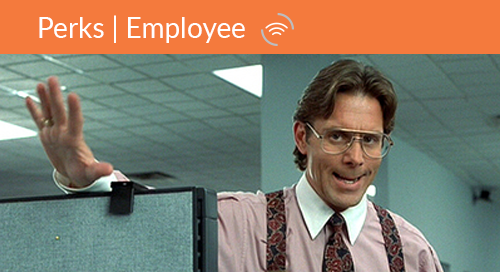Who Do You Work For? How Different Motivators Affect Employee Engagement

 December is upon us, and it’s getting tough to shake the smell of evergreen trees and gingerbread walking through most public places. As we gather this season with our loved ones, acquaintances, and people we haven’t met before, a question sure to come up: who do you work for? It’s a piece of small talk most of us haven’t put much thought into, but it can say a lot about your employee engagement level and what really motivates you to obey your 7:30 am alarm each morning.
December is upon us, and it’s getting tough to shake the smell of evergreen trees and gingerbread walking through most public places. As we gather this season with our loved ones, acquaintances, and people we haven’t met before, a question sure to come up: who do you work for? It’s a piece of small talk most of us haven’t put much thought into, but it can say a lot about your employee engagement level and what really motivates you to obey your 7:30 am alarm each morning.
“Motivation is powerful. It predicts success better than intelligence, ability, or salary.”
Eric Barker, TIME
I work for my manager.
There is a fundamental difference between the ways millennials view their workplaces and the way past generations thought about work. Today’s employees are prioritizing strong relationships with their managers, and are less insistent about other factors. In 2015, one study showed 50% of workers said bad managers was the reason they left their job. In this case, employee engagement levels are strongly tied to their relationship with a supervisor.
It might sound silly to say a person works for their manager, but personal relationships are intrinsic motivators that hold far more power than any reward or compensation. Rewards and recognition solutions should be implemented as a means of facilitating personal relationships instead of a ‘cattle prod’ that makes employees work faster.
There’s an inherent ‘strangeness’ to hierarchical relationships between manager and employee that’s difficult to ignore. Modern employees often find it's considerably easier to sort through the strangeness when they feel as though you can joke about it with the person asking for their weekly reports.
“Millennials do not believe that productivity should be measured by the number of hours worked at the office, but by the output of the work performed. They view work as a ‘thing’ and not a ‘place.”
-The Atlantic
Who? I work for my paycheck!
Yes, obviously. Money is high up on everyone’s list of motivators because we all have certain needs that must be met to live sustainably. However, research suggests that there’s a very important caveat to using tangible rewards as a primary motivator. For dynamic tasks that require higher amounts of cognitive skill cash and tangible incentives often decrease employee efficiency. Author Daniel Pink gave an excellent TED talk where he points out there’s actually an inverse relationship between the size of the tangible reward offered and the efficiency at which someone performs a complex task.

”The Candle Problem” is a famous experiment that a psychologist named Karl Dunker came up with that requires participants to light and fix a candle to a wall in such a way that the wax doesn’t drip onto the table. They can use only the matches, the box of thumbtacks, and the candle itself. Most people attempt to nail the candle to the wall or to melt the bottom of the candle and glue it to the wall. The solution (right) requires the participant to overcome thinking about the box of thumbtacks as a container for the thumbtacks and place the candle inside it while fixing the box to the wall.
So let’s bring money into the picture. Psychologist Sam Glucksburg, wondered if cash incentives would help people perform the task faster and more efficiently. What he found was fascinating - the higher the cash reward the worse participants did performing the candle task. The key finding was that tangible rewards aren’t effective as the lone motivator for tasks that require a high level of cognitive skill. Author Daniel Pink (who wrote about these experiments and others) offers a severe warning that when used thoughtlessly “rewards just motivate people to get rewards, when the rewards stop, people stop”. Effective employee engagement solutions use tangible rewards to facilitate grander, intangible motivators, and don’t pay off their participants.
I work for myself.
The most powerful motivator of all is that inner spark that gives your coworker the pep in their step, the curious twinkle in their eye. The employee who comes to work every day because they believe in what they’re doing or love their field will undoubtedly perform at the highest level.
Every office is certainly unique, and carries its own challenges - but just ask Google how their 20% time program has delivered results for them. The program allows employees spend a fifth of their time on side projects or professional development. This program accounted for 50% of the new products google released each year, including apps like Gmail and Google News. Another example is Atlassian (creators of the ticketing software “JIRA”), which runs a similar program called ‘Shipit’. Each quarter they take an entire day to develop creative ideas independent of their employees other work. At these companies employee engagement is tied to their desire to learn, deliver a great product, and collaborate with their peers. These are excellent examples of policies that foster intrinsic motivation, and carry the most power.
Having employees who work for themselves doesn’t mean removing managers and allowing the office to turn into a lawless swamp. Having employees who work for themselves instead means redefining the workplace as somewhere ‘things’ are built collaboratively instead of a ‘place’ where workers show up.
For businesses struggling with employee retention this can significantly decrease turnover. Tinypulse released results of an investigation revealing that employees who have lots of freedom to make decisions about how to do their jobs are 28% less likely to think about leaving their jobs.
So this holiday season, as you return for a second plate of ham and cranberry sauce think about who you work for, and who your employees work for, as it can really make a difference.






